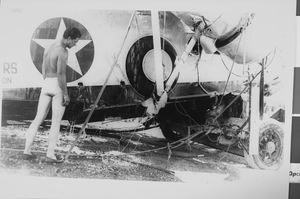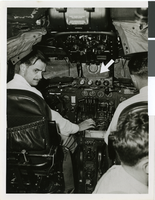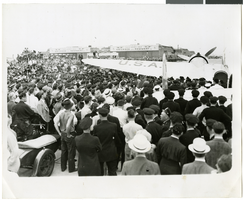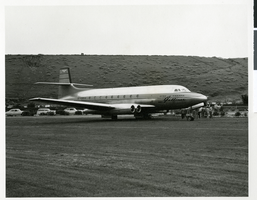Search the Special Collections and Archives Portal
Search Results

Photograph of Howard Hughes's Sikorsky S-43 at Lake Mead, circa 1943
Date
1943
Archival Collection
Description
A close up view of the side of Howard Hughes's Sikorsky S-43 on the shore of Lake Mead after being retrieved from the water.
Image

Photographs for press release, Hughes demonstrates new radar warning, May 1, 1947
Date
1947-05-01
Archival Collection
Description
Photographs that accompany the attached press release: "HUGHES DEMONSTRATES NEW RADAR WARNING Howard Hughes, at the controls of the TWA Constellation, demonstrates the efficiency of his new radar safety device, which is being installed on all TWA planes and which will be available to all other airlines in the United States as soon as he can produce the equipment. The instrument warns the pilot by a brilliant red light and a warning horn the instant the plane comes too close to the ground, or any building, bridge, mountain, aircraft or other obstacle, regardless of darkness or weather conditions. The device weighs only 16 pounds and costs about $130. (Arrow points to warning lights on instrument panel). Center photo shows the Hughes-piloted Constellation approaching a mountain in Southern California's Santa Monica Range, an area usually voided by pilots because of its dangerous peaks. This particular plane's radar set was equipped with both 500-feet and 2,000-feet warning signals. The 500-feet warning range now being installed on TWA airliners was developed first because the greatest immediate need for it is during approaches and landings. The 2,000-feet warning is designed from enroute flying to guarantee clearance of mountains and other obstacles. Photo at right shows the Constellation veering to the left and climbing at a speed of 300 miles an hour after receiving radar warning of an obstacle in its flight path."
Image

Photograph of crowds at Floyd Bennett Airfield, New York, July 1938
Date
1938-07-14
Archival Collection
Description
The black and white view of Howard Hughes' Lockheed 14 aircraft after performing its final landing on the Round the World flight at Floyd Bennett Airport, New York. Description printed on photograph's accompanying sheet of paper: "Howard Hughes reception at Floyd Bennett Field 7/14/38."
Image

Photograph of a jet plane designed by Howard Hughes, circa 1940s-1950s
Date
1940 to 1959
Archival Collection
Description
A plane, designed by Howard Hughes, parked on a field with a group of people in the foreground. The plane is numbered, CF-EJO-X, and it is an Avro Canada Jetline.
Image
Howard Hughes taking off in the Northrop Gamma Racer from Miami, Florida to New York in an attempt for a speed record, 1936 January
Level of Description
File
Archival Collection
Howard Hughes Public Relations Photograph Collection
To request this item in person:
Collection Number: PH-00373
Collection Name: Howard Hughes Public Relations Photograph Collection
Box/Folder: Folder 01
Collection Name: Howard Hughes Public Relations Photograph Collection
Box/Folder: Folder 01
Archival Component
Photograph of painting with Howard Hughes in flight suit, undated
Level of Description
File
Archival Collection
Hughes Electronics Corporation Records
To request this item in person:
Collection Number: MS-00485
Collection Name: Hughes Electronics Corporation Records
Box/Folder: Box 01
Collection Name: Hughes Electronics Corporation Records
Box/Folder: Box 01
Archival Component

Photograph of Hiram "Tommy" Thurlow and the Lockheed 14, New York, July 9, 1938
Date
1938-07-09
Archival Collection
Description
The black and white view of Hiram "Tommy" Thurlow and the Lockheed 14 aircraft in New York, New York. Typed on a piece of paper attached to the image: "Readying Hughes' plane for Paris flight. New York City-- Mechanics hastened to put Howard Hughes' Lockheed 14 monoplane in shape for a flight from Floyd Bennett Airport here, to Paris. Motor trouble forced postponement and helpers were working under injunction to have the ship ready for a takeoff "at the earliest possible moment," July 9. Photo shows: Lieut, Thomas A. Thurlow, navigator, calibrating compass on plane. Credit Line (ACME) 7/9/1938."
Image
"Howard Hughes: Flying Boat", 1984 April 11
Level of Description
File
Archival Collection
Hughes Electronics Corporation Records
To request this item in person:
Collection Number: MS-00485
Collection Name: Hughes Electronics Corporation Records
Box/Folder: Box 15
Collection Name: Hughes Electronics Corporation Records
Box/Folder: Box 15
Archival Component
"Howard Hughes: The Movie Maker", 1984 April 11
Level of Description
File
Archival Collection
Hughes Electronics Corporation Records
To request this item in person:
Collection Number: MS-00485
Collection Name: Hughes Electronics Corporation Records
Box/Folder: Box 15
Collection Name: Hughes Electronics Corporation Records
Box/Folder: Box 15
Archival Component

Las Vegas City Attorney Howard Cannon pictured with Las Vegas city officials: photographic print
Date
1950 (year approximate) to 1958 (year approximate)
Archival Collection
Description
From the Howard Cannon Photograph Collection (PH-00192). Left to right are R. W. Notti (Assistant City Manager), A. H. Kennedy (City Manager), Cannon, Shirley Ballinger (City Clerk), Mayor C. D. Baker, Commissioner E. W. Fountain, Commissioner Reed Whipple, Commissioner Harris P. Sharp, and Commissioner Wendell Bunker.
Image
Pagination
Refine my results
Content Type
Creator or Contributor
Subject
Archival Collection
Digital Project
Resource Type
Year
Material Type
Place
Language
Records Classification
